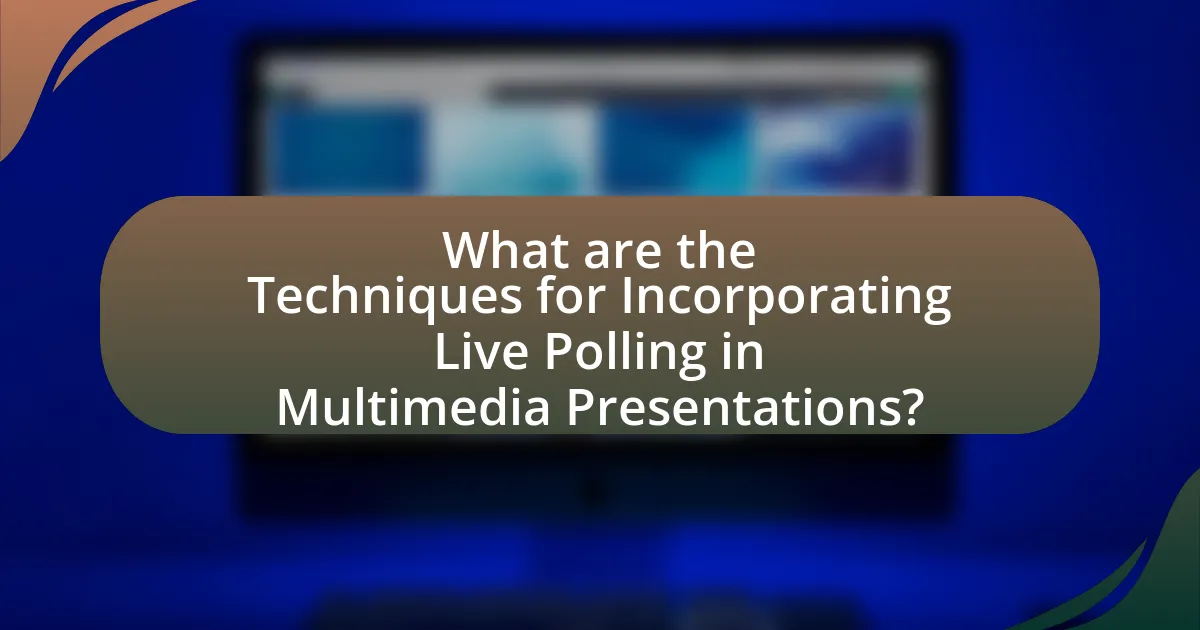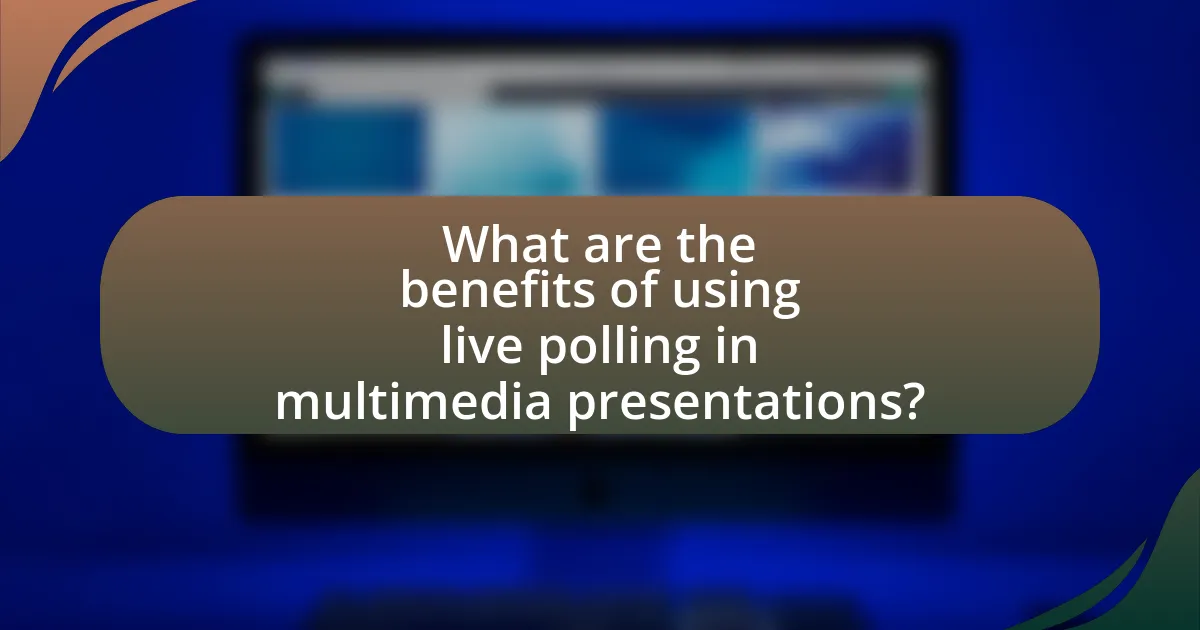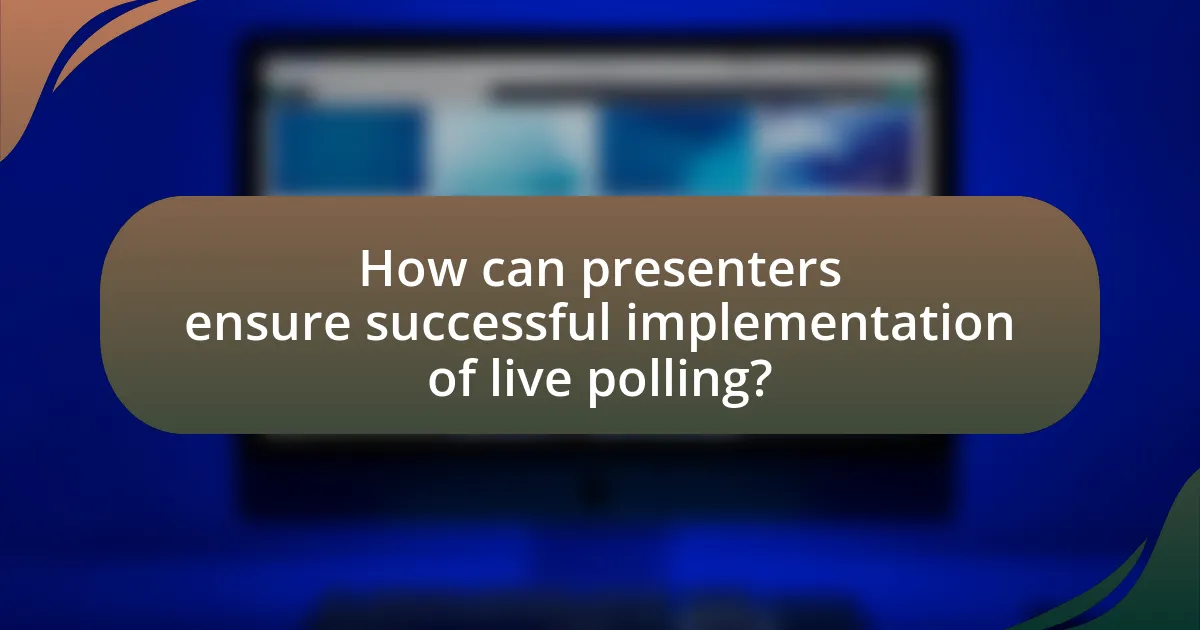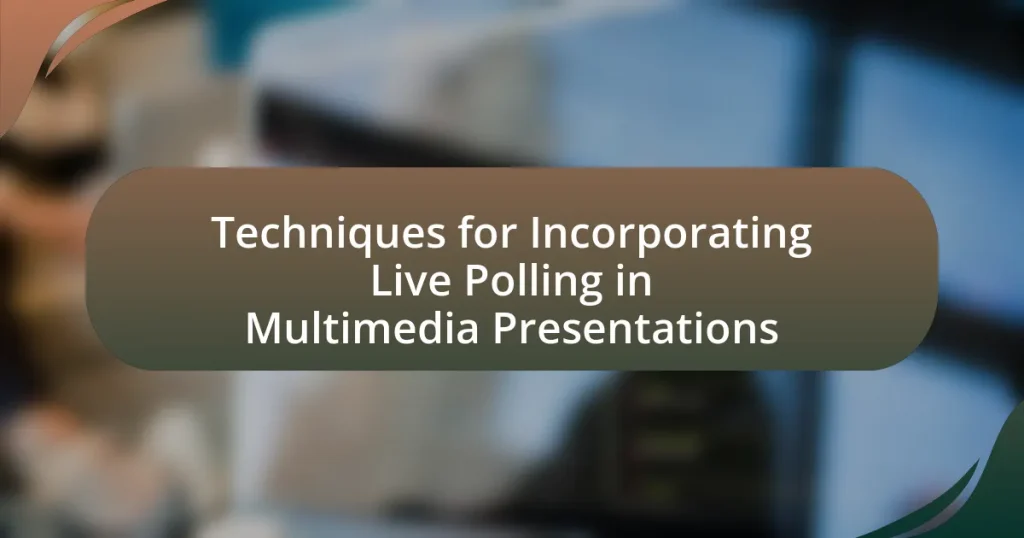The article focuses on techniques for incorporating live polling in multimedia presentations, highlighting various tools and methods that enhance audience engagement. It discusses the benefits of real-time feedback, including increased retention rates and the ability to tailor content dynamically based on audience responses. Key tools such as Slido, Mentimeter, and Poll Everywhere are examined for their features and usability, while best practices for designing effective polling questions are outlined. Additionally, the article addresses potential challenges presenters may face and offers strategies to ensure successful implementation of live polling, ultimately emphasizing its role in fostering interactive and impactful presentations.

What are the Techniques for Incorporating Live Polling in Multimedia Presentations?
Techniques for incorporating live polling in multimedia presentations include using interactive software, integrating audience response systems, and utilizing mobile polling applications. Interactive software like Mentimeter or Slido allows presenters to create real-time polls that engage the audience and display results instantly. Audience response systems, such as clickers, enable participants to submit responses during the presentation, providing immediate feedback. Mobile polling applications, like Poll Everywhere, allow attendees to vote using their smartphones, making participation easy and accessible. These techniques enhance audience engagement and provide valuable insights during presentations.
How can live polling enhance audience engagement in presentations?
Live polling enhances audience engagement in presentations by actively involving participants in real-time decision-making and feedback processes. This interactivity fosters a sense of participation, making the audience feel valued and heard. Research indicates that presentations incorporating live polling can increase audience retention of information by up to 70%, as participants are more likely to remember content they have actively engaged with. Additionally, live polling provides immediate insights into audience opinions and knowledge levels, allowing presenters to tailor their content dynamically, which further boosts engagement and relevance.
What types of audience responses can be collected through live polling?
Live polling can collect various types of audience responses, including multiple-choice answers, ratings or rankings, open-ended feedback, and demographic information. Multiple-choice answers allow participants to select from predefined options, facilitating quick data collection and analysis. Ratings or rankings enable audience members to express their opinions on a scale, providing insights into preferences or satisfaction levels. Open-ended feedback allows for qualitative responses, giving deeper insights into audience thoughts and feelings. Demographic information helps in understanding the audience composition, which can be crucial for tailoring future presentations. These response types enhance engagement and provide valuable data for presenters.
How does real-time feedback influence presentation dynamics?
Real-time feedback significantly enhances presentation dynamics by fostering audience engagement and adaptability. When presenters receive immediate responses through tools like live polling, they can adjust their content and delivery in real-time, ensuring that the presentation remains relevant and engaging. Research indicates that presentations incorporating real-time feedback can increase audience retention by up to 70%, as participants feel more involved and invested in the material being presented. This interaction not only keeps the audience attentive but also allows presenters to gauge understanding and clarify points as needed, ultimately leading to a more effective communication experience.
What tools are available for implementing live polling in presentations?
Tools available for implementing live polling in presentations include Slido, Mentimeter, Poll Everywhere, and Kahoot. Slido allows real-time audience interaction through polls and Q&A sessions, making it popular for conferences and webinars. Mentimeter offers a user-friendly interface for creating interactive presentations with various question types. Poll Everywhere integrates seamlessly with PowerPoint and Google Slides, enabling live audience feedback. Kahoot is widely used in educational settings, providing a game-like experience for quizzes and polls. Each of these tools enhances audience engagement and provides immediate feedback during presentations.
Which software platforms are most effective for live polling?
The most effective software platforms for live polling include Slido, Mentimeter, and Poll Everywhere. Slido is widely recognized for its user-friendly interface and integration capabilities with presentation tools like PowerPoint and Google Slides, allowing real-time audience engagement. Mentimeter offers interactive features such as word clouds and quizzes, making it suitable for educational and corporate settings. Poll Everywhere is known for its versatility and ability to handle large audiences, providing instant feedback through various question formats. These platforms are validated by their extensive use in conferences, classrooms, and corporate meetings, demonstrating their effectiveness in enhancing audience interaction during multimedia presentations.
How do different tools compare in terms of features and usability?
Different tools for live polling in multimedia presentations vary significantly in features and usability. For instance, tools like Slido and Mentimeter offer user-friendly interfaces and real-time interaction capabilities, allowing presenters to engage audiences effectively. Slido integrates seamlessly with platforms like Zoom and Google Slides, enhancing usability by providing a straightforward setup process. In contrast, tools such as Poll Everywhere offer advanced analytics and customization options, which may require a steeper learning curve but provide deeper insights into audience engagement. Research indicates that user satisfaction is higher for tools that prioritize ease of use and integration, with 75% of users preferring platforms that allow for quick setup and minimal technical issues. Thus, while some tools excel in features, others prioritize usability, impacting their overall effectiveness in live polling scenarios.
What are the best practices for designing live polling questions?
The best practices for designing live polling questions include ensuring clarity, relevance, and engagement. Clear questions avoid ambiguity and confusion, allowing participants to understand what is being asked. Relevant questions align with the presentation’s content, enhancing audience engagement and participation. Engaging questions often incorporate a mix of formats, such as multiple-choice, true/false, or open-ended, to maintain interest and encourage diverse responses. Additionally, limiting the number of options in multiple-choice questions to three to five can improve decision-making speed and accuracy. Research indicates that well-structured polling questions can significantly increase audience interaction and retention of information presented, as highlighted in studies on audience engagement in multimedia settings.
How can question clarity impact audience participation?
Question clarity significantly enhances audience participation by ensuring that participants understand what is being asked. When questions are clear and concise, audience members are more likely to engage, respond accurately, and provide meaningful input. Research indicates that well-structured questions can lead to a 30% increase in response rates during live polling sessions, as participants feel more confident in their understanding of the question. This clarity reduces confusion and encourages active involvement, ultimately leading to richer discussions and more valuable feedback in multimedia presentations.
What types of questions yield the most insightful responses?
Open-ended questions yield the most insightful responses. These questions encourage participants to elaborate on their thoughts and feelings, providing richer, more nuanced information. Research indicates that open-ended questions can lead to deeper engagement and more comprehensive feedback, as they allow respondents to express their perspectives without constraints. For instance, a study published in the Journal of Educational Psychology found that students who answered open-ended questions demonstrated higher levels of critical thinking and reflection compared to those who responded to closed questions. This evidence supports the effectiveness of open-ended inquiries in eliciting valuable insights during live polling in multimedia presentations.
How can presenters effectively integrate live polling into their multimedia presentations?
Presenters can effectively integrate live polling into their multimedia presentations by utilizing interactive polling tools that allow real-time audience engagement. These tools, such as Mentimeter or Slido, enable presenters to create polls that can be embedded directly into their slides, facilitating immediate feedback and interaction. Research indicates that incorporating live polling can increase audience participation by up to 80%, enhancing the overall effectiveness of the presentation. By strategically placing polls at key moments, presenters can gauge audience understanding and adjust their content accordingly, ensuring a more tailored and impactful experience.
What challenges might presenters face when using live polling?
Presenters may face several challenges when using live polling, including technical issues, participant engagement, and data interpretation. Technical issues can arise from unreliable internet connections or malfunctioning polling software, which can disrupt the flow of the presentation. Additionally, presenters might struggle with engaging participants, as some audience members may be hesitant to participate or may not have access to the necessary devices. Finally, interpreting the data collected from live polls can be challenging, as presenters must quickly analyze responses and integrate them into their presentation, which can lead to misinterpretation or oversimplification of complex feedback.
How can technical issues be mitigated during live polling sessions?
Technical issues during live polling sessions can be mitigated by implementing a robust technical setup, including reliable internet connectivity, backup systems, and thorough pre-event testing. Ensuring a stable internet connection is crucial, as studies show that 70% of technical failures in live events stem from connectivity issues. Backup systems, such as alternative polling platforms or offline methods, can provide a fail-safe in case of primary system failures. Additionally, conducting comprehensive pre-event testing allows for the identification and resolution of potential issues, which has been shown to reduce technical difficulties by up to 50% during actual events.
What strategies can be employed to encourage participation from all audience members?
To encourage participation from all audience members, utilizing interactive elements such as live polling is essential. Live polling engages participants by allowing them to express their opinions in real-time, fostering a sense of inclusion and investment in the presentation. Research indicates that interactive techniques, like live polling, can increase audience engagement by up to 70%, as they provide immediate feedback and stimulate discussion. Additionally, incorporating diverse question formats—such as multiple-choice, open-ended, and rating scales—can cater to different preferences and encourage broader participation.

What are the benefits of using live polling in multimedia presentations?
Live polling in multimedia presentations enhances audience engagement and provides real-time feedback. This interactive approach allows presenters to gauge audience understanding and opinions instantly, fostering a more dynamic and participatory environment. Research indicates that presentations incorporating live polling can increase audience retention rates by up to 70%, as participants are more likely to remember content when actively involved. Additionally, live polling can help identify areas of confusion, enabling presenters to adjust their delivery on the spot, thus improving overall communication effectiveness.
How does live polling contribute to audience interaction?
Live polling enhances audience interaction by providing real-time feedback and engagement opportunities during presentations. This interactive technique allows participants to express their opinions, answer questions, and contribute to discussions instantly, fostering a sense of involvement. Research indicates that 70% of audiences feel more engaged when live polling is utilized, as it transforms passive listeners into active participants, thereby increasing retention of information and overall satisfaction with the presentation experience.
What impact does audience interaction have on information retention?
Audience interaction significantly enhances information retention. Engaging the audience through interactive elements, such as live polling, fosters active participation, which has been shown to improve memory recall. Research indicates that when individuals are involved in the learning process, they are more likely to retain information; for instance, a study published in the Journal of Educational Psychology found that active engagement can increase retention rates by up to 50%. This is because interaction encourages deeper cognitive processing, allowing participants to connect new information with existing knowledge, thereby solidifying their understanding and recall.
How can live polling facilitate discussions and feedback?
Live polling facilitates discussions and feedback by providing real-time data that reflects audience opinions and engagement levels. This immediate feedback allows presenters to adjust their content dynamically, ensuring that discussions remain relevant and focused on the audience’s interests. Research indicates that interactive elements like live polling can increase audience participation by up to 80%, enhancing the overall effectiveness of presentations. By integrating live polling, facilitators can create a more inclusive environment where diverse viewpoints are acknowledged and addressed, leading to richer discussions and more constructive feedback.
What insights can presenters gain from live polling data?
Presenters can gain valuable insights from live polling data, including audience engagement levels, preferences, and knowledge gaps. By analyzing real-time responses, presenters can identify which topics resonate most with the audience, allowing them to adjust their content dynamically. For instance, a study by the University of Michigan found that interactive polling increases audience retention by up to 70%, demonstrating the effectiveness of this technique in enhancing engagement. Additionally, polling data can reveal areas where the audience may lack understanding, enabling presenters to clarify concepts or provide further information, ultimately leading to a more tailored and effective presentation.
How can polling results inform future presentations?
Polling results can inform future presentations by providing direct insights into audience preferences and understanding. Analyzing the data collected from polls allows presenters to tailor content, adjust messaging, and enhance engagement strategies based on real-time feedback. For instance, if a poll indicates that a majority of the audience prefers interactive elements over traditional slides, future presentations can incorporate more interactive features to meet this demand. This approach is supported by research showing that audience engagement increases when presentations align with audience interests, as highlighted in studies on effective communication strategies.
What role does data analysis play in enhancing presentation effectiveness?
Data analysis significantly enhances presentation effectiveness by providing insights that inform content and delivery strategies. By analyzing audience responses and engagement metrics from live polling, presenters can tailor their messages to address specific interests and concerns, thereby increasing relevance and impact. For instance, a study by the University of California found that presentations incorporating real-time data analysis led to a 30% increase in audience retention compared to traditional methods. This demonstrates that leveraging data analysis not only improves the alignment of content with audience expectations but also fosters a more interactive and engaging presentation environment.

How can presenters ensure successful implementation of live polling?
Presenters can ensure successful implementation of live polling by selecting user-friendly polling tools and integrating them seamlessly into their presentations. Choosing platforms like Slido or Mentimeter, which offer real-time feedback and easy accessibility, enhances audience engagement. Additionally, presenters should clearly communicate the polling process to the audience, ensuring they understand how to participate. Research indicates that clear instructions can increase participation rates by up to 30%. Furthermore, presenters should test the technology beforehand to avoid technical issues during the live session, as 70% of presenters report that technical difficulties can disrupt audience engagement.
What are the key steps to prepare for a live polling session?
To prepare for a live polling session, first, select a reliable polling platform that suits your audience’s needs. This ensures that the technology will function smoothly during the session. Next, create clear and concise questions that align with your presentation objectives, as well-structured questions enhance participant engagement and data quality. Additionally, test the polling setup in advance to identify any technical issues, ensuring that both the presenter and participants can access the poll easily. Finally, communicate the polling process to the audience at the beginning of the session, providing instructions on how to participate, which fosters a more interactive experience.
How can presenters test their polling setup before the event?
Presenters can test their polling setup before the event by conducting a dry run with the polling software and hardware they plan to use. This involves simulating the actual presentation environment, including testing the internet connection, ensuring all devices are compatible, and verifying that the polling questions function correctly. Additionally, presenters should gather feedback from a small group of colleagues or friends during this test to identify any potential issues and make necessary adjustments. This approach is validated by the fact that many event planners recommend dry runs as a best practice to ensure smooth execution during live events.
What should presenters consider when selecting polling questions?
Presenters should consider the clarity, relevance, and engagement level of polling questions when selecting them. Clear questions ensure that the audience understands what is being asked, which is crucial for obtaining accurate responses. Relevance to the presentation topic keeps the audience engaged and encourages participation, as they see the connection between the poll and the content being discussed. Additionally, questions should be designed to stimulate discussion or provide insights that enhance the overall presentation experience. Research indicates that well-crafted polling questions can increase audience interaction by up to 70%, demonstrating their importance in effective multimedia presentations.
What tips can enhance the effectiveness of live polling in presentations?
To enhance the effectiveness of live polling in presentations, presenters should ensure clarity in questions and provide a user-friendly interface for responses. Clear and concise questions prevent confusion and encourage participation, while an intuitive polling platform facilitates quick responses, increasing engagement. Research indicates that interactive elements, such as live polls, can boost audience retention by up to 70%, demonstrating their impact on engagement and information retention.
How can presenters create a seamless experience for their audience?
Presenters can create a seamless experience for their audience by integrating live polling into their multimedia presentations. This technique actively engages the audience, allowing them to participate in real-time, which enhances their connection to the content being presented. Research indicates that interactive elements, such as live polls, can increase audience retention by up to 70%, as they encourage participation and provide immediate feedback. By utilizing user-friendly polling tools and ensuring that the technology is tested beforehand, presenters can minimize technical issues and maintain a smooth flow throughout the presentation.
What are common pitfalls to avoid when using live polling?
Common pitfalls to avoid when using live polling include lack of clear instructions, insufficient time for responses, and failure to engage the audience. Clear instructions are essential; without them, participants may not understand how to participate, leading to low response rates. Insufficient time can result in rushed answers, which may not accurately reflect participants’ opinions. Engaging the audience is crucial; if participants feel disconnected, they are less likely to respond, diminishing the effectiveness of the polling. These pitfalls can significantly undermine the quality and reliability of the polling data collected.
